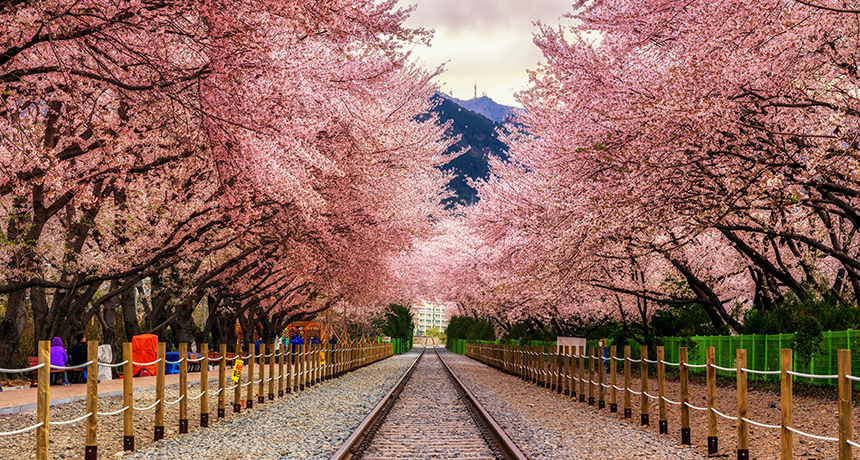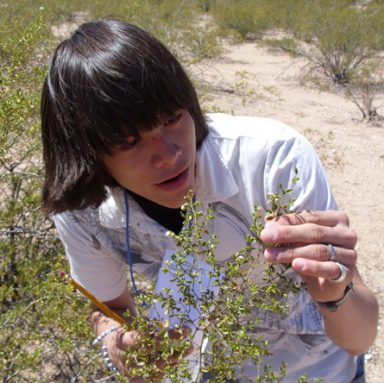Springing forward
Climate change affects the timing of flowering, migration and other natural cycles, meaning spring is coming earlier in many parts of the world.

The timing of when plants bloom or sprout, when fish spawn or insects molt, can all depend on features like day length, temperatures and other aspects of weather. With global warming, this timing can move up in the year, confusing pollinators and disrupting ecosystems.
AaronChoi/iStock/Getty Images Plus
It’s not just Daylight Savings Time that came early this year. All around the world, spring seems to be coming sooner than it used to. It hasn’t moved up on the calendar — but many cycles in nature are telling us that spring just can’t wait to be sprung.
Dandelions push through the soil and bloom weeks earlier than they did decades ago. Robins who migrated for the winter are shortening their stays down south. In some places, butterflies usually not seen until July have been flitting about since January. That’s great, right? After all, nearly everyone looks forward to spring’s arrival after a long, cold winter.
 |
|
Lowell Cemetery in Lowell, Massachusetts on May 30, 1868, and May 30, 2005.
|
| R. Primack, anonymous |
Not so fast, say many scientists. A growing body of evidence suggests these shifts in timing are coming about because of climate change. And these changes might spell trouble for the countless species of plants and animals that depend on one another.
Timing is everything
“The timing of life cycles in nature really matters a lot,” says Abe Miller-Rushing, a scientist at the Rocky Mountain Biological Laboratory in Crested Butte, Colo. Miller-Rushing is one of a growing number of scientists investigating how climate change affects the timing of events in nature.
“Many organisms time their life cycles with the seasons,” he says. “Relationships between species could be disrupted as a result of changes in timing.”
Climate change, however, is a long-term phenomenon. To confidently say that climate change affects natural cycles, such as the date when maple trees first unfurl their leaves, scientists need to document what day the event occurs over many years. Then, they need to compare those dates with climate factors such as average temperature or rainfall over long periods of time — ideally decades. Finally, they need to figure out if changes in the timing of natural events are connected to changes in climate patterns.
“One of the big limitations to understanding how climate change affects plants and animals is you need data from a long time, and there just isn’t a lot of that out there,” Miller-Rushing says.So scientists need to be creative in their hunt for data.
Turning to history
Miller-Rushing turned to a long-dead figure in American history and literature for help. Henry David Thoreau, a writer and naturalist who lived in suburban Boston during the mid-1800s, kept detailed diaries of the natural cycles in his surroundings. In these diaries, he recorded the flowering times of hundreds of plants in eastern Massachusetts.
 |
|
Kids in Arizona inspect plants for hints of early flowering.
|
| D. Amber |
To compare Thoreau’s observations with today’s cycles, Miller-Rushing and his colleague at Boston University tracked the first flowering date for 43 of those species during the years 2004, 2005 and 2006.
They found that plants like violets and buttercups are blooming on average seven days earlier than they did in Thoreau’s time. And some species, such as wild blueberries, bloom three weeks earlier than they did 150 years ago.
Seven days might not seem like that much time. But many plants rely on insects to move their pollen from one flower to another — a crucial step in plant reproduction. And some plants only produce flowers for about a week, says Richard Primack, a conservation biologist at Boston University.
“If flowering shifts a week or two earlier and the insects that pollinate it are not coming out, it’s possible that the species won’t be pollinated, and it won’t set fruit,” Primack says.
That’s significant for two reasons. First, when a plant “sets fruit,” it makes the seeds that will become the next generation of plants. If a plant doesn’t set fruit, it doesn’t reproduce.
Second, many birds rely on fruit as a food source — especially in the fall when they are building up their energy stores to migrate south for the winter. If plants aren’t pollinated in the spring, this food resource won’t exist in the fall.
But scientists are still learning how climate change may affect communities of plants and animals. “Right now, we only know the relationships are changing,” Primack says. “Now we’re actively researching the effect these changing relationships will have on species.”
It’s not only wildlife that’s feeling the effects of these shifting cycles, says Christine Rogers. She is a biologist at the University of Massachusetts Amherst who studies how pollen, fungal spores and bacteria in the air affect people. She says kids with allergies might be sniffling and sneezing earlier than ever before.
“We know that the spring seasons are coming earlier, and that means the pollen people are allergic to is coming out earlier,” she says. “The timing of the allergy season is shifting to an earlier time period.
Citizen scientists
Understanding how nature responds to climate change will require monitoring key life cycle events — flowering, the appearance of leaves, the first frog calls of the spring — all around the world. But ecologists can’t be everywhere so they’re turning to non-scientists, sometimes called citizen scientists, for help.
A group of scientists and educators launched an organization last year called the National Phenology Network. “Phenology” is what scientists call the study of the timing of events in nature.
One of the group’s first efforts relies on scientists and non-scientists alike to collect data about plant flowering and leafing every year. The program, called Project BudBurst, collects life cycle data on a variety of common plants from across the United States. People participating in the project — which is open to everyone — record their observations on the Project BudBurst website.
“People don’t have to be plant experts — they just have to look around and see what’s in their neighborhood,” says Jennifer Schwartz, an education consultant with the project. “As we collect this data, we’ll be able to make projections about how plants and communities of plants and animals will respond as the climate changes.”
That data will help scientists predict not only how natural communities may change but also how these changes will affect people, says Jake Weltzin. He’s the executive director of the National Phenology Network.
Weltzin says scientists monitoring lilac flowering in the western United States reported that in years when lilacs bloomed early — before May 20th — wildfires later in the summer and fall tended to be larger and more severe. Lilac blooming, then, could serve as an alarm bell, he says.
“If we had a network of people collecting this information, scientists could use that information to come up with a nationwide tool for predicting fires in the west,” Weltzin says.
Down the road, he says the National Phenology Network plans to coordinate with other monitoring programs, such as the Cornell Laboratory of Ornithology’s Great Backyard Bird Count, the University of Kansas’ Monarch Watch or the National Wildlife Federation’s FrogWatch USA. Closer coordination will help scientists recognize new patterns, such as whether a change in the timing of flowering affects insect population levels.
Improved monitoring is an important step toward predicting how natural communities will respond to climate change, Miller-Rushing says.
“The best way for us to increase our knowledge of how plants and animals are responding to climate change is to increase the amount of data we have,” he says. “That’s why we need citizen scientists to get as much information from as many places on as many species over as long a time period as we can.”







